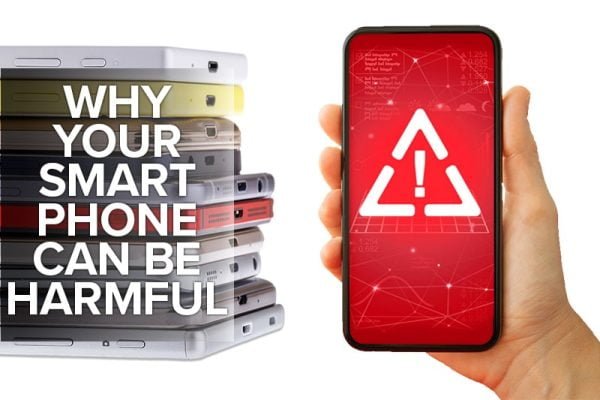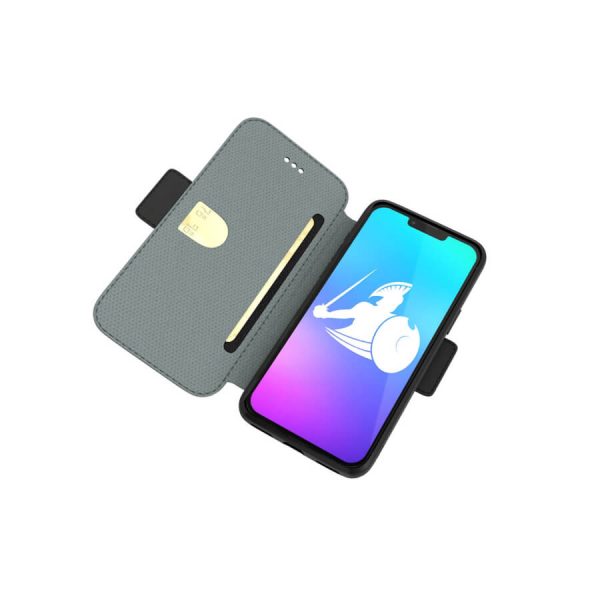Your cart is currently empty!

Top 10 Reasons Your Cell Phone May Be Bad For You & The Planet
Last Updated on October 4, 2023

In our modern lives, cell phones and other devices have become irreplaceable. Fifty-three percent of children now own a smartphone by age eleven. Eighty-four percent of teenagers have their own phone. And out of all Americans, 96% own a cellular device.
With such widespread usage, it is hard to imagine that cell phones and other wireless devices could be unsafe. However, while cell phones do have many benefits in our modern era, it is always beneficial to be mindful of the often overlooked negative effects of these devices.
Top 10 Negative Effects of Smartphones
1) EMF Radiation Exposure
Of course we have to mention the negative effects of Electromagnetic Field (EMF) radiation, which every electronic device, including your wireless smartphone, emits almost constantly while it’s turned on.
Cell phones operate between frequencies of 450-2000 MHz, but the most common phones today use 800-900 MHz. With 5G, these frequencies will eventually go up to 300 GHz, covering a much broader frequency range. Additionally, the amount of power a phone uses depends on what it’s doing—during a call, more power is consumed versus when it is locked.
While the small size of a smartphone makes its power level relatively low, with it glued to your body all day it becomes a prevalent source of EMF radiation exposure, regardless of its power level. You receive more EMF radiation exposure from your phone than nearby cell towers.
EMF radiation levels emitted by your cell phone have been linked to a whole list of health issues, including but not limited to:
- Chronic headaches and neurological effects
- Insomnia
- Infertility
- Developmental effects
- Hormonal imbalances
- Gut issues
- Cancer
The International Agency for Research on Cancer has identified EMFs as a possible carcinogen.
Many are unaware that the health symptoms they are suffering from might be related to their cell phone and wireless radiation exposure. While it is unrealistic to get rid of your mobile devices and electronics, recognizing that they can have a biological effect on your body and reducing your exposure when you can will help protect you from chronic symptoms.
In addition to reducing your device use when you can, it may be a good idea to have proper protection on your phone to prevent EMFs from reaching your body. You can use an EMF radiation shielding case—this can help protect your head, the most important part of your body, while making phone calls. You can also carry your device in an EMF radiation protection hip pack, pouch, or holster to put a protective layer between your device and your body.
2) Germs
A study from Arizona University found that phones often carry 10 times more bacteria than most toilet seats. Disgusting!
Every time we fall ill, we have germs and bacteria to thank. The average mobile phone has 25,127 bacteria per square inch. Your phone is a breeding ground for germs because of how many different surfaces it comes in contact with: hands, bag/purse, counter tops, car seats. Every time it touches something, the germs are transferred between the surface and phone. Additionally, germs are able to thrive on phones because they stay warm throughout the day, between body heat and battery heat.
One study from the University of Oregon identified over 7,000 different types of bacteria present on phones, but the most common were Streptococcus, Staphylococcus, and Corynebacterium. These types of bacteria can make a person sick. Each phone has its own unique biome of bacteria, created by the people and places it encounters.
Think about it—when was the last time you cleaned your phone? We find ourselves frequently washing our hands and cleaning the spaces around us. But handheld devices—including phones, remote controls, tablets, etc.—are often overlooked. When these devices are passed around, the germs spread from one person to the next.
The global pandemic of COVID-19 that started in early 2020 brought to many people’s attention the importance of containing the spread of germs. Phones and other devices are sneaky transporters of germs, so make sure to clean phones and devices frequently. And please, try not to take your phone into the bathroom.
3) Blue Light
Blue light is everywhere in our daily lives: from the sunshine outdoors, to fluorescent lighting and mobile devices and electronic screens.
Natural light is made up of the visible spectrum—red, orange, yellow, green, blue, indigo, and violet light combine to make the white light we perceive as sunlight. With all the screens present in our lives, there is an abundance of artificial blue light. Blue light is on the higher end of the visible spectrum with shorter wavelengths, and thus, more energy.
Blue light has many benefits:
- It increases alertness
- Helps memory and cognitive functions
- Elevates mood
- Regulates our body’s circadian rhythm
- Helps to develop children’s eyes
The problems with blue light exposure arise when you have too much of it, especially when it should not be naturally present. Phones are the worst culprit because we often hold our phones closest to our eyes, increasing the intensity of the blue light.
Blue light penetrates all the way to the retina, increasing the risk for damaging the light-sensitive cells. This can cause macular degeneration, which can lead to permanent vision loss. Digital eye strain can also happen as a result of overexposure.
You may have feelings of discomfort after looking at a screen for more than two hours, leading to:
- Dry eyes
- Headaches
- Blurred vision neck or shoulder pain.
It seems that blue light might also be harming the skin on your face. More evidence is showing that blue light exposure from screens can lead to skin aging, specifically fine lines, wrinkles, and skin discoloration.
Another direct impact from cell phone’s blue light is on the circadian rhythm. Exposure to blue light quells the secretion of melatonin, the natural hormone that is related to sleep, thus throwing off your sleep cycle.
Stephen Lockley, a Harvard sleep researcher, noted that even a low level of blue light at night can disrupt your sleep. In general, light is one of the main reasons that the people do not get enough sleep at night. However, blue light is the most harmful. One study compared blue light exposure to green light exposure, and the results showed that the blue light suppressed melatonin secretion twice as long as the green light did.
Try limiting your screen time, especially at night, to help give your eyes a rest and keep your sleep cycle intact. You may also wear a pair of Blue Light Blocking Glasses to filter out the excessive blue light from screens. Additionally, many devices allow you to alter the display settings to night mode, which automatically shifts the screen colors to a warmer color palette, decreasing the amount of blue light.
4) Brain Development
The brain is one of the most vulnerable organs in the body. It’s also the most important, since it controls all of the functions and processes constantly occurring.
When you use your phone, it alters the brain and its development. While it is difficult to separate which effects come from EMF radiation and which come from the act itself of looking at your phone or electronic device, device use is still directly related to brain changes.
One study conducted at Harvard had 47 volunteers whose brain activity was measured twice by a PET scanner. Each person had a cell phone strapped to each ear. In the first scan, both phones were off. In the second scan, one phone was on. The results showed that when one phone was on, that side of the brain had an increase in the use of glucose (metabolism) near the phone’s antenna. These results show that human brains are sensitive to cell phone radiation exposure from acute cell phone use, and the researchers said these results could be indicative of other neurotransmitter and neurochemical changes due to EMF frequencies.
What’s especially worrisome is the long-term impact on brain development in children. Children are still growing, so their skulls are thinner than an adults’, which makes them more susceptible to harm. A report in JAMA Pediatrics found a connection between increased screen time during childhood and poor progression in key developmental areas such as communication skills, problem solving, and social interactions over time.
The younger generation has grown up with technology, meaning they’ve been exposed to the harmful effects of it their whole lives. Because cell phones are still relatively new, long-term exposure studies do not yet exist. However, as the data surrounding screen time and children continues to grow, there is more and more evidence to suggest increased screen time is related to developmental issues regarding memory, attention, and language skills.
Based on the Adolescent Brain Cognitive Development study, researchers from the National Institutes of Health provided two big takeaways:
- MRI scans found significant differences in the brains of some children who reported using smartphones, tablets, and video games more than seven hours a day.
- Children who reported more than two hours a day of screen time got lower scores on thinking and language tests.
Increased screen time is related to the premature thinning of the cortex. The cerebral cortex, often referred to gray matter, includes sensory areas and motor areas, so it processes information related to the senses and motor functions.
What’s very concerning is that young people are also losing their ability to remember phone numbers and read maps, because they have become too reliant on their phones to do those tasks for them.
Mind you, there are benefits to having all this technology, especially when it comes to virtual learning, but there must be a balance in the amount of time spent on these devices to help lessen the negative impacts of phones.
5) Social Interactions
Modern technology has done wonders to connect the globe.
From your phone, you can text your friend across the country, WhatsApp a pen pal on a different continent, or retweet someone in a different time zone. It’s amazing how people can connect with others from around the world, but the ability to do so has actually impacted social settings and face-to-face interactions. A study from the University of Essex found that just having a phone present in a social situation diminishes the quality of the interactions. By being hyper-connected to people through phones, actual connections with other humans have declined.
Since 2007 (when the first iPhone came out… coincidence?) teenagers are spending less time hanging out with their friends, are in less of a rush to get a driver’s license, are going out on fewer dates, are more likely to feel lonely, and are less likely to get enough sleep.
The Essex study also determined that when there is a phone present, it can give off a negative first impression, interfere with interpersonal closeness, and prevent the development of trust.
The younger generations’ social habits have changed and are different than older generations because they’re digital natives—they grew up in a technologically saturated world.
Almost half of Millennials (39%) interact more with their smartphone than with their significant others, parents, friends, children, or co-workers. One specific social interaction that has seen a direct impact is romance. According to Match.com, younger generations have less structured, in-person dates, and instead spend more time communicating digitally.
Next time you’re hanging out with friends, on a date, or at a family get-together, make it a point to set aside your phone so that you can be present in the moment.
6) Mental Health
There is a connection between increased screen time and the rise in mental health issues among teenagers. Since 2008, the use of mobile device usage and mental illness have been following a very similar rising curve. Research has shown that social media, Internet addiction, and the negative impacts of EMF radiation is taking a toll on peoples’ mental health.
Yearly, 1 in 5 adults experience a mental illness. Additionally, the suicide rate is on the rise, especially for young adults and adolescents. In 2012, over 50% of Millennials had a smartphone. Coincidentally, that same year, psychological well-being took a dip. This study has revealed an established link between screen time and your mental health state.
Scientists have even created a term to describe the relationship people may have with their phones. “Nomophobia” means the fear of losing your cell phone or being without it. Scientists are looking closer at the psychological connection between a person and their phone, and have determined it stems from two factors.
First, the feeling of anxiety related to not having your phone or not having a working phone. Second, the reliance on phones to do everything: keep phone numbers, Google questions, provide GPS directions, track workouts, the list goes on.
The dependency on phones does not bode well for mental health. Less face-to-face interaction means compromised social relationships, which is a major risk factor for developing Depression. This increased screen time, leading to a lack of physical connection while fostering through social media a “compare and despair” attitude and feelings of inadequacy, is being pinpointed as a cause for rising mental illness among youth.
A link between phones and stress has been established. In a study evaluating the psychosocial risks of cell phones, it argues that stress is related to “feeling compelled to promptly respond to cell-phone activity in order to maintain spontaneity and access with others.“
Victoria Strohmeyer, a registered psychotherapist with UCHealth Yampa Valley Medical Center, stated that getting a phone notification actually activates the sympathetic nervous system, the part of the body that’s always scanning the environment. It will trigger a shot of adrenaline that will create a domino effect, increasing heart rate, pulse, muscle tension, and transferring energy from the brain to our muscles. It can take up to 30 minutes for your body to return to homeostasis, but when phones are constantly pinging with alerts, it can lead to chronic stress, which can develop into further health problems like heart disease, depression, sleep deprivation, and chronic fatigue.
Next time you are feeling like your screen time is affecting your mental state, try stepping away from your devices and taking a digital detox. Detoxing is the first step in overcoming an addiction, and many people are, in fact, addicted to their phones.
In today’s society, we usually need our phones for one reason or another. But taking a detox could lead to decreased phone usage, which may help your mental health. To learn more about mobile devices and their relationship with mental health, check out our mental health and EMF article.
7) Distraction
Screen time is on the rise thanks to smartphones and other devices that contribute to our hyper-connected lifestyle. One survey from the NY Post found that Americans spend 42% of their waking hours looking at a screen. This includes looking at phones, tablets, computers, TVs, and other screens.
In March 2020, the Coronavirus caused many peoples’ screen time to increase, even though device usage was already high.
When it comes to looking at phone screens, another report that studied 11,000 users of the app, RescueTime, found that the average person had 3 hours and 15 minutes of screen time. The high end of users had over 4.5 hours of phone usage.
But how many people actually have 4 hours of their day completely free to look at their phones? Not many.
Phones are an easy distraction from work, school, working out, and even consuming other media like streaming and podcasts. Oftentimes, it’s easier to just stay occupied by your phone rather than do something else–or even when you are doing something else.
Some experts blame the rise of smartphones for fueling the multitasking culture. According to Mike Olson, a senior analyst at Piper Jaffray, “the ability to participate in most of these activities, with an additional device beyond your TV or your PC, has had a huge impact on multitasking, and therefore consumption of more media or content.”
But the human brain can’t actually consciously focus on more than one thing at a time, and trying to do so has led to everything from lower academic test results, to lower-quality social interaction, and even to more accidents and emergency room visits.
According to the Governors Highway Safety Association, there were almost 6,000 pedestrian fatalities in the U.S. in 2017—a number last seen in the 90s—with experts suspecting distracted walking as the primary cause. Similar to texting while walking, “multitasking” on your phone while driving has become a deadly habit.
The National Highway Traffic Safety Administration found that 9% (3,000) of fatal car crashes in the U.S. in 2017 were attributed to a distracted driver. Additionally, 599 non-occupants (pedestrians and bikers, for example) were killed by a distracted driver. And the largest proportion of distracted drivers were in the 15-19 age group, which is also the age group that grew up attached to phones.
Cell phones are literally killing people on the road. Researchers from the Virginia Tech Transportation Institute found that cell phones create a tangible threat to drivers by creating a distraction. Using your phone while driving—texting, checking an email, dialing a number—creates a prolonged time that the driver is not paying attention to the road. Texting caused the driver to take their eyes off the road for an average of 23 seconds and doubled the risk of fatal crashes. When making a phone call, from reaching for your phone, looking up a contact and dialing the number, the crash risk triples.
Since screens are now ubiquitous in society, make a point to step away from mobile devices and screens. Many devices have built-in screen time usage limits you can set, so that when you hit the allotted time, the app shuts down. There’s also a variety of apps you can download to your phone to prevent phone use while driving.
8) Physical Pain
Over many years, the human body has evolved to adapt to its lifestyle and the situations it encounters. Since phones have become a staple in today’s life, our bodies make physical changes because of our phone usage.
When you use your phone for activities besides phone calls, oftentimes you are looking down at it. Believe it or not, this can cause an injury. “Text neck” is a term coined by Dr. DL Fishman, a chiropractor. He describes it as a “repeated stress injury and pain in the neck resulting from excessive watching or texting on handheld devices over a sustained period of time.”
Any time you tilt your head forward, you are putting additional pounds of force on your neck. Tilting your head 30 degrees forward puts about 40 pounds of force on your neck, and it increases to 60 pounds at 60 degrees. That is equivalent to the weight of a child.
Text neck can lead to shoulder pain, upper back pain, headaches, and increased thoracic kyphosis—a hunched back. In the long run, it may cause early onset arthritis, spinal misalignment, spinal degeneration, disc compression, muscle weakness, and loss of lung capacity.
In addition to text neck, “text claw” refers to the feelings of soreness and cramping in your fingers, wrist, and forearm after spending too much time on your phone. While it’s not an official medical diagnosis, many people can relate to these feelings after over-usage.
Dr. Aaron Daluiski, chief of the Hand and Upper Extremity Service at the New York-Presbyterian Hospital/Weill Cornell Medical Center in New York City, explained that constant use of handheld devices can exacerbate certain conditions, and can even cause tendinitis, which is inflammation of the tendons.
Prolonged use of phones can worsen temporary pain into permanent problems. One report from the Journal of Orthopaedic Case Reports found that abuse of touch screen phones can lead to Trapeziometacarpal osteoarthritis, or rather arthritis in the bottom of the thumb joint. More doctors are seeing an increase of young adults with arthritis pain as a result from their technology usage. Dr. Vipul N. Nanavati, an orthopedic specialist and director of the upper extremity program at the Orthopedic Specialty Hospital at Mercy Medical Center in Baltimore, says that the most common place young adults are developing arthritis is at the base of the thumb because of the repetitive hand use.
Another physical ailment people may develop thanks to cell phones stems from Electromagnetic Hypersensitivity, commonly referred to as EHS. EHS sufferers experience symptoms as a result of being more sensitive to EMFs than the average person. Symptoms can create physical pain like tingling, nausea, headaches, and muscle weakness. To learn more about EHS, here’s an article for you.
Addressing feelings of pain and soreness in your neck, upper body, arms, and hands is important to prevent long-term damage. Remember to take breaks, apply heat or ice depending on the type of pain, and move your body and stretch out your muscles.
9) Environmental Impact
Researchers from McMaster University found that over the last decade, the environmental impact from our modern technology has worsened. Since 2007, the industry’s carbon footprint has tripled, and it is estimated by 2040 to make up 14% of the global carbon footprint.
While devices are shrinking—from once giant brick cell phones to now palm-sized devices—the drastic rise in the number of devices and their power usage is detrimental.
Phones are the worst offenders of electronic devices because they are more disposable than other devices. They typically have a two-year average life cycle, so phones are constantly being thrown out. Discarded electronics are the world’s fastest growing waste problem. A study from United Nations University found that in 2016, 43 million tons of electronic waste was disposed of, a rise of 8% from the previous two years. Here’s a staggering picture: the weight of the e-waste is equivalent to nine Great Pyramids of Giza or 4,500 Eiffel Towers, according to UK’s The Telegraph.
When you get rid of your old phone, you need to get a new phone, so the production of smartphones is through the roof. The hardware within smartphones, specifically the chip and the motherboard, require rare materials (gold and silver, for example). The mining of those materials does not come without significant environmental impact. In fact, mining the rare materials accounts for up to 95% of the device’s total CO2 emissions during its lifespan. It would take an entire decade of charging and operating a smartphone to balance out how much energy it takes to buy a new smartphone.
Sending texts, posting on Instagram, or checking email all requires data. While that data is essentially a virtual stream of 0s and 1s, it has tangible impacts. In order for your phone to send and receive data, it must be processed through data centers. These data centers are massive warehouses chock full of servers. This uses an extensive amount of power to run, and to keep the servers cool. To learn more about the environmental impact of data centers, check out this article.
With the introduction of 5G, we will not only exponentially increase our power usage and environmental footprint, but 5G and EMF frequencies also have a negative effect on many plants, animals, and ecosystems.
10) Privacy and Security
Smartphones do so much more than simply make phone calls, and because of that should not be overlooked as a serious threat to our privacy.
Since they are always on (who can remember the last time you actually turned off your phone?), your phone is constantly being tracked. The GPS chip that enables your map app to safely guide you to the nearest Starbucks on your road trip also tracks your every move. Turning off your GPS antenna won’t make you untraceable. Engineering researchers at Princeton University discovered that other sensors in the hardware can still be used to find and track your phone.
Connecting to public WiFi is also a way people can be tracked. Nordstrom came under fire in 2013 when it was made known that it used the service Euclid Analytics to track shoppers when they connected to the store’s public WiFi.
Location tracking does have its benefits, like when you use Find My iPhone after misplacing it for the thousandth time. But, it also allows hackers and thieves to know where your phone, and most of the time you, are. It can be leveraged against you to know your location 24/7. A person with malicious intent could use your location to determine where you live, where you work, what school your children attend, when you are out running errands, when you go on vacation, and pretty much all of your daily movements and habits. Or they could sell all this information. It’s scary to think what could be done with this data.
Another privacy issue surrounds all the apps people download on their phones. A lot of times, when an app is downloaded, you agree to the app permissions, usually without reading them. But why does the photo editing app need access to your GPS and contacts? If you don’t feel comfortable agreeing to those permissions, find another app to use because there are plenty of other options. Agreeing to provide personal information to unknown app developers is an invasion of privacy.
Have more concerns about privacy in the digital world? Check out this blog article to learn more and find out ways you can protect yourself.
Related Posts
None found























































